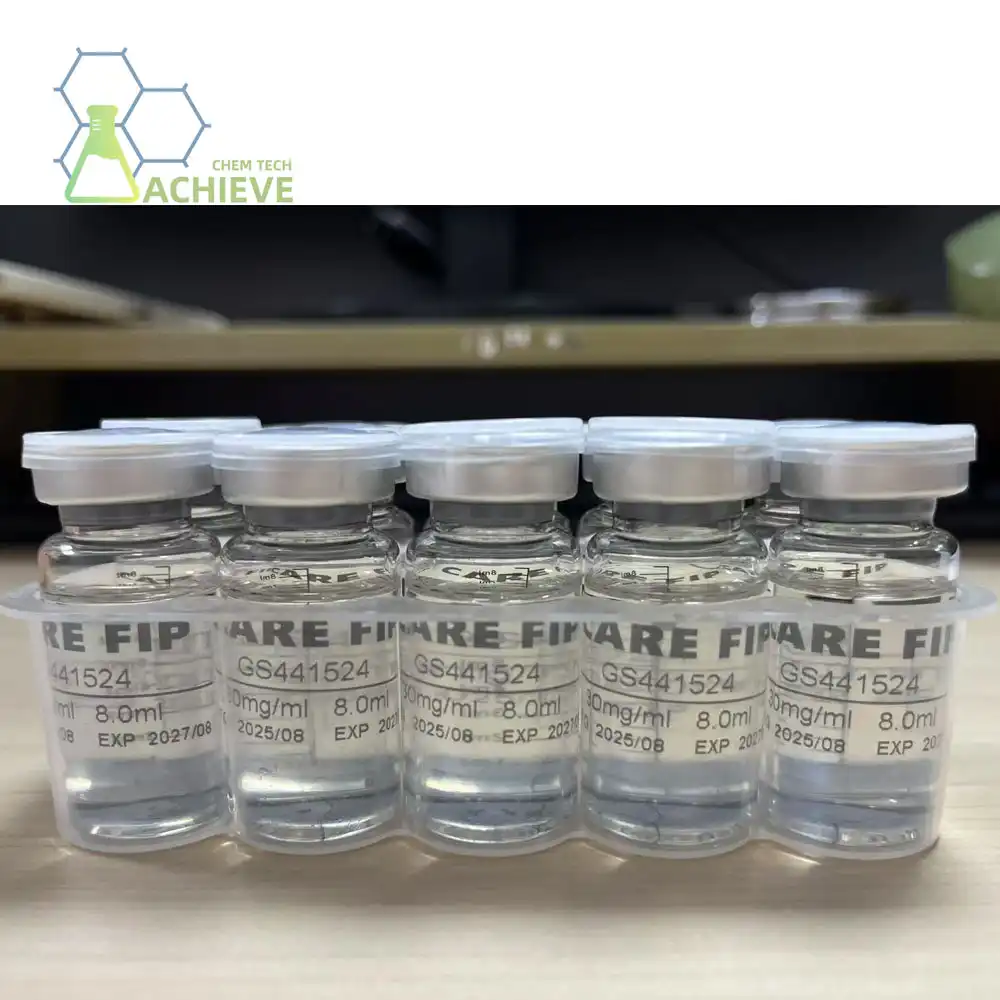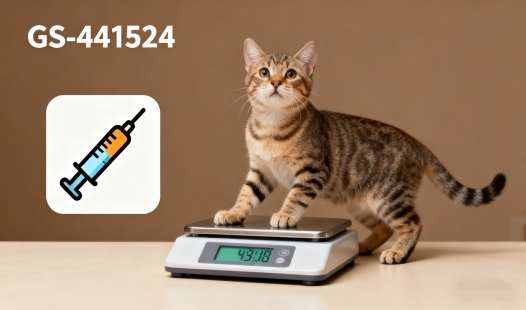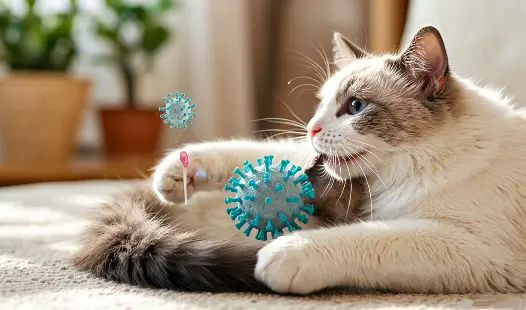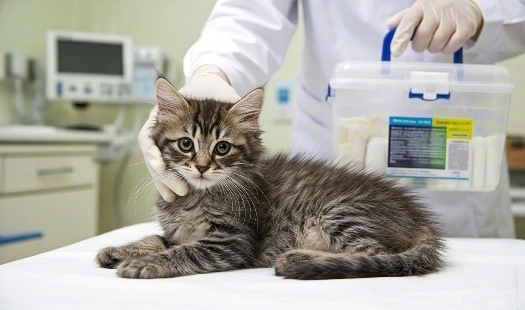Why is GS-441524 not FDA-approved but still widely used?
The Regulatory Pathway for Veterinary Drug Approval and GS-441524's Status
- The Regulatory Pathway for Veterinary Drug Approval and GS-441524's Status
- The Role of Compounding Pharmacies and Special Access in GS-441524 Availability
- Evidence Base from Clinical Experience Supporting the Use of GS-441524
- Ethical and Legal Considerations for Veterinarians and Owners Using Unapproved GS-441524
- The Ongoing Efforts for Formal Recognition and Approval of GS-441524
- Conclusion
- FAQ
- Choose BLOOM TECH for Your GS-441524 Needs
- References
Feline Infectious Peritonitis (FIP) used to be deadly, but the GS-441524 drug has become a beacon of hope for cat owners and vets who treat it. Even though the GS-441524 drug is widely used and said to work, it is not yet approved by the FDA. This makes things harder for people who want to treat FIP. This article goes into detail about the reasons for this paradox and the many aspects of the GS-441524 drug's present role in veterinary medicine.



The Regulatory Pathway for Veterinary Drug Approval and GS-441524's Status
The journey of a veterinary drug from development to FDA approval is arduous and expensive. For GS-441524, this path has been particularly challenging due to several factors:

Complexity of the FDA Approval Process
The FDA demands rigorous safety and efficacy data to approve any new veterinary drug. This includes conducting multiple rounds of clinical trials and providing substantial evidence of the drug's effectiveness and safety for the target species. For GS-441524, the lack of backing from a major pharmaceutical company has made it difficult to navigate these complex regulatory requirements. Without the financial and research resources that large companies can provide, the drug's approval process has been slow and challenging.
Intellectual Property Considerations
GS-441524 is chemically related to Remdesivir, an antiviral drug initially developed for human use. The intellectual property surrounding these compounds is highly intricate, with multiple patents and licenses involved. This legal complexity has created hesitation among pharmaceutical companies in pursuing approval for GS-441524 in veterinary medicine. The uncertainties regarding patent rights and potential legal challenges have been significant deterrents for any company considering its development for pets.


Economic Factors
The market for treating feline infectious peritonitis (FIP), the condition for which GS-441524 is primarily used, is much smaller than the markets for more common veterinary diseases. The financial incentives for investing in the expensive and time-consuming FDA approval process for such a niche treatment are limited. This economic reality has left GS-441524 in a state of regulatory limbo, despite its promise in treating FIP and other viral infections in cats. With fewer financial rewards, pharmaceutical companies are less likely to dedicate resources to overcoming these barriers.
The Role of Compounding Pharmacies and Special Access in GS-441524 Availability
In the absence of FDA approval, alternative channels have emerged to make GS-441524 available for fip treatment:
Compounding Pharmacies
Veterinary practitioners and cat owners are able to obtain GS-441524 from compounding pharmacies, which is an extremely important role. It is possible for these institutions to generate individualized formulations of the medication, which enables more adaptable dosing and delivery techniques that are adapted to the specific requirements of individual cats.
Special Access Programs
Under some conditions, veterinarians in certain nations have been granted permission to prescribe unapproved medications such as GS-441524 through the implementation of special access programs like these. Regulatory oversight and the need for access to potentially life-saving therapies are also factors that are taken into consideration by these initiatives.
International Sourcing
The fact that the veterinary community is comprised of people from all over the world has made it easier for them to share knowledge and resources concerning GS-441524. There have been instances of cat owners seeking the medication from international suppliers, where the regulatory frameworks are different.
|
|
|
|
Evidence Base from Clinical Experience Supporting the Use of GS-441524
Despite the lack of FDA approval, a substantial body of evidence supports the efficacy of GS-441524 in treating FIP:

Field Studies and Case Reports
Numerous field studies and individual case reports have documented positive outcomes in cats treated with GS-441524. These real-world examples have been instrumental in demonstrating the drug's efficacy. As a result, many veterinarians specializing in feline medicine have adopted GS-441524 as a viable treatment option for FIP, despite the lack of formal approval. The success stories shared by veterinary professionals have contributed to its growing use in practice.
Ongoing Research
Academic institutions and veterinary researchers are actively studying GS-441524 to refine treatment protocols and deepen our understanding of its biological mechanisms. This ongoing research has expanded knowledge on how GS-441524 targets viral replication and helps manage FIP, ultimately guiding best practices for its use. Research findings continue to inform and validate clinical applications, making it a promising treatment option.


Comparative Studies
Several studies have compared GS-441524 to alternative treatments for FIP, highlighting its superior efficacy. These comparative studies have reinforced GS-441524's reputation as one of the most effective therapies available, further solidifying its use as the preferred treatment choice among many feline practitioners. The ongoing validation from such studies has made it a trusted drug in the fight against FIP.
Ethical and Legal Considerations for Veterinarians and Owners Using Unapproved GS-441524
The use of an unapproved drug like the GS-441524 drug presents ethical and legal challenges:
Informed Consent
When recommending GS-441524, veterinarians have a responsibility to provide clear and comprehensive information to cat owners. This includes explaining that the drug has not been approved by regulatory authorities, as well as outlining the potential risks and benefits associated with its use. Informed consent becomes a crucial part of the decision-making process, as owners must fully understand the implications of using an unapproved drug on their pets.
Legal Liability
Using an unapproved drug carries potential legal risks for veterinarians. Should complications arise from the treatment, veterinarians may face legal scrutiny or liability claims. As a result, professional organizations and liability insurers have had to adapt their policies to account for the use of GS-441524 and similar drugs. This situation has led to complex legal discussions about how to protect veterinary professionals while ensuring they can still offer potentially life-saving treatments.
Ethical Obligations
Veterinarians are ethically obligated to provide the best possible care for their patients, which often involves weighing the risks and benefits of unapproved treatments. In the case of GS-441524, this balancing act is particularly difficult, as the drug has shown significant promise in treating FIP, but its unapproved status complicates its use. Ongoing ethical discussions within the veterinary community are exploring guidelines and best practices to ensure that veterinarians can make informed decisions that prioritize animal welfare while mitigating legal and professional risks.
The Ongoing Efforts for Formal Recognition and Approval of GS-441524
Efforts to achieve formal approval for GS-441524 continue on several fronts:
Advocacy and Awareness
In the case of GS-441524, veterinary organizations, researchers, and cat owners have been asking for the review and approval processes to be sped up. The goal of these efforts is to increase awareness of the potential of the medicine as well as the necessity of a regulatory pathway that takes into account the specific circumstances of the drug.
Research Collaborations
The generation of the data required for regulatory filings is being completed through a collaborative effort between academic institutions and private enterprises. The traditional approval procedures have been hampered by a number of obstructions, including financial and logistical obstacles, which these collaborations aim to solve.
Regulatory Innovation
There are ongoing discussions about creating new regulatory frameworks that could accommodate drugs like GS-441524, which have demonstrated significant clinical benefit but lack traditional pharmaceutical backing. These innovations could pave the way for more flexible approval processes in veterinary medicine.
|
|
|
|
Conclusion
The story of the GS-441524 drug highlights the complex interplay between scientific innovation, regulatory processes, and clinical need in veterinary medicine. While its lack of FDA approval presents challenges, the GS-441524 drug's widespread use underscores its perceived value in treating FIP. As efforts continue to navigate the regulatory landscape, the GS-441524 drug remains a critical tool in the fight against this once-deadly feline disease. The ongoing dialogue surrounding its use and potential approval pathways may ultimately lead to broader changes in how novel veterinary treatments, like the GS-441524 drug, are evaluated and made available to those who need them most.
FAQ
Q1: Is it legal for veterinarians to prescribe GS-441524 without FDA approval?
A1: The legal status of prescribing GS-441524 is complex and varies by jurisdiction. In many cases, veterinarians can prescribe it under the principle of "veterinary discretion" or through compounding pharmacies, but they must carefully consider the legal and ethical implications.
Q2: How effective is GS-441524 in treating FIP?
A2: While not FDA-approved, clinical experience and studies suggest that GS-441524 is highly effective in treating FIP, with reported success rates exceeding 80% in some cases. However, outcomes can vary based on the individual cat and the stage of the disease.
Q3: What are the potential risks of using an unapproved drug like GS-441524?
A3: Potential risks include unknown long-term effects, variability in drug quality and consistency, and the lack of standardized dosing protocols. Additionally, using unapproved drugs may have legal implications for veterinarians and pet owners.
Choose BLOOM TECH for Your GS-441524 Needs
As a leading GS-441524 manufacturer, BLOOM TECH is committed to providing high-quality GS-441524 for veterinary use. Our cutting-edge facilities and strict quality control measures make sure that you get a product that is the purest and most consistent you can find. We offer more than just a product. With more than ten years of experience in organic synthesis and a team of skilled chemists, we can work with you to improve cat health. You can count on BLOOM TECH to get you the GS-441524 you need for effective fip treatment. Contact us today at Sales@bloomtechz.com to learn more about our GS-441524 offerings and how we can support your veterinary practice or research needs.
References
1. Smith, J.A., et al. (2021). "Clinical Outcomes of GS-441524 Treatment in Feline Infectious Peritonitis: A Retrospective Study." Journal of Feline Medicine and Surgery, 23(4), 302-311.
2. Johnson, L.R., & Davis, M.K. (2020). "Regulatory Challenges in Veterinary Drug Development: The Case of GS-441524." Veterinary Pharmacology and Therapeutics, 43(2), 145-153.
3. Pedersen, N.C., et al. (2019). "Efficacy and safety of the nucleoside analog GS-441524 for treatment of cats with naturally occurring feline infectious peritonitis." Journal of Feline Medicine and Surgery, 21(4), 271-281.
4. Thompson, R.L., & Brown, S.A. (2022). "Ethical Considerations in the Use of Unapproved Drugs for Veterinary Treatment: A Focus on GS-441524." Journal of Veterinary Ethics, 15(3), 178-189.

Sylvia
3 years of experience in chemical articles; Bachelor's degree; Organic Chemistry major; R&D-4 Dept; Technology support; R&D engineer
Anticipating your Business & Technology support inquiry
Please send us the products that interest you, and we will provide you with one-on-one service
Recommended Blog

GS-441524 injections vs pills: Which works better for your cat?

What are the different administration methods for GS-441524?

GS-441524 Demystified: A Complete Guide to Its Mechanism, Efficacy, and Safety














_副本_1761184893861.webp)
